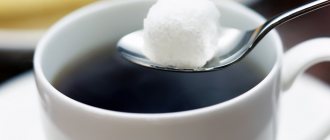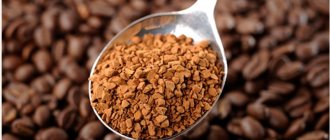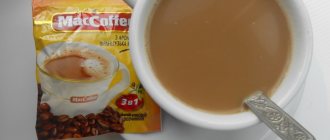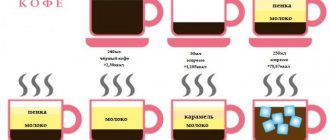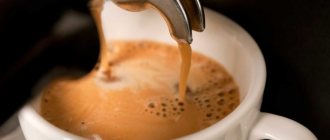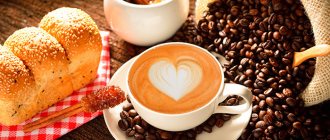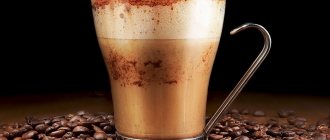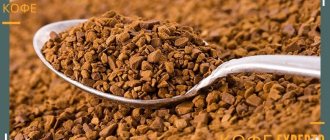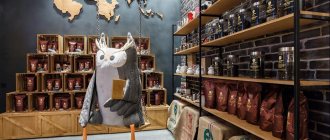Good afternoon, today we will look at the topic of how many calories are in 1 spoon of coffee. Our readers often asked us what the calorie content of coffee is in one or two spoons. In this article we will try to talk about this in more detail. In order to find out how many calories are in a spoon of coffee, you need to know the weight of the spoon. We can find out in our previous article how many grams are in a spoon of coffee. We must not forget that the number of grams in a spoon also changes depending on the GRIND of the coffee. In our calculations we will try to come to averages. Not everyone can boast of a figure and a healthy body, but the most important thing is proper nutrition.
How many calories are in a coffee spoon?
1 coffee spoon (heaped) = 2.38 kcal
1 coffee spoon (without slide) = 1.19 kcal
* 100 grams of instant coffee = 119 calories
Calorie content of supplements
- 1 teaspoon of sugar will increase the calorie content of coffee by 24 kcal
- 10 g cream – for 20-60 kcal (depending on fat content)
- 2 tbsp. spoons of milk 2.6% – 21 kcal
- 1 teaspoon of condensed milk – 35 kcal
- 1 teaspoon of chocolate syrup – 15 kcal
- A scoop of ice cream weighing 50 g – 113.5 kcal
Calorie content of a teaspoon of coffee (question, answer)
- How many calories are in 1 teaspoon of coffee (without a slide)? = 2.38 calories
- How many calories are there in one heaping teaspoon of coffee? = 3.57 calories
- 2 teaspoons of coffee (without slide) how many calories? = 4.76 calories
- How many calories are in two heaping teaspoons of coffee? = 7.14 calories
- 3 teaspoons of coffee (without slide) how many calories? = 7.14 calories
- How many calories are in three heaping teaspoons of coffee? = 10.71 calories
Calorie content of a tablespoon of coffee (question, answer)
- How many calories are in 1 tablespoon of coffee (without a slide)? = 7.14 calories
- How many calories are in one heaping tablespoon of coffee? = 10.71 calories
- 2 tablespoons of coffee (without slide) how many calories? = 14.28 calories
- How many calories are there in two heaping tablespoons of coffee? = 21.42 calories
- 3 tablespoons of coffee (without slide) how many calories? = 21.42 calories
- How many calories are in three heaping tablespoons of coffee? = 32.13 calories
Calorie content of different types of coffee
The calorie content in instant coffee without sugar depends on its type, since different varieties and different processing technologies of coffee beans when creating an instant product affect its composition and digestibility. According to the results of testing several brands of instant coffee, the tested samples contained different amounts of kilocalories:
- Milagro Gold contains only 150 kcal per 100 grams of product.
- The Black Card Gold is even less caloric - 92.4 kcal.
- Jacobs Monarch has 101 kcal.
- Ambassador Coffee has a much higher energy value - 329 kilocalories per 100 grams.
- The record holder for the lowest amount of calories is Nescafe Gold. 100 grams of coffee contain only 49 kilocalories.
How to distinguish from a fake?
The Jacobs brand is known all over the world, so some unscrupulous manufacturers counterfeit popular products, cashing in on customer trust.
Sometimes it is very difficult to distinguish a counterfeit Jacobs from the original, but if you pay attention to some important nuances, the chance of not purchasing a counterfeit increases significantly
How to distinguish a fake from the original:
Price. Branded products cannot be cheap, so if you see a dubious number on the price tag, there will probably be chicory or malt inside the can or bag. Package. The manufacturer uses glass or tin containers to package its products so that the aroma of coffee is preserved for as long as possible. Counterfeiters choose the cheapest packaging for packaging counterfeit coffee, usually made of plastic. Product design. The marking of the original coffee is applied directly to the container. There should be no stickers or additional labels. The manufacturer must indicate the following information: country where the product was produced, original barcode, expiration date. Barcode. It carries important information for the consumer. The first three digits indicate the country of manufacture
It is important to calculate the numbers using a special formula so that the verification number matches. Packaging design. The original packaging fully matches the manufacturer's style
Often, counterfeiters copy the design and apply the company logo, swapping the letters.
The secret to making delicious coffee
What is the secret of delicious coffee? In the craftsmanship. Jacobs will help you make real and fragrant coffee without much difficulty. Thanks to the different recipes that the Jacobs brand offers, you can prepare a very tasty drink that will amuse both you and your family.
Recently, Jacobs coffee has been presented on store shelves in the latest unique packaging. Of all the states, Our First Motherland brought out the Jacobs Monarch in a refreshed form. But soon such a jar of fragrant coffee will appear in Poland, the Czech Republic, Romania, the Baltic countries, Ukraine and other countries.
After Jacobs appeared in Russia, and this came out in 1989, the design of the can did not actually change. Consumers were comfortable with this packaging and today’s updated version retains the main elements of the Jacobs Monarch style.
The new can is much brighter and more interesting. She also changed the shape of the lid and the label. Although the label retained all the elements of the corporate identity, it became even more catchy and modern.
Brand history
When, in January 1895, the inhabitants of Bremen saw an advertisement in the newspaper about the opening of “a special coffee, tea, biscuit and chocolate store,” they could not even imagine that they were witnessing the birth of a brand of global importance.
Born into the family of an ordinary German peasant, Johann Jacobs studied aspects of trade in colonial products at a commercial school, where he decided to engage in the supply of coffee. He moved to Bremen to open his own business in 1894, having previously worked in two companies involved in the trade of coffee beans. Johann was only 26 when he opened his own store on the busiest street in Bremen.
The small store quickly became popular - the friendly and smiling young man behind the counter tried to please every customer at all costs, simply remembered names and tastes, and gave discounts to regular customers. The implementation was so successful that in 1907 the businessman was able to open his own factory for roasting coffee beans. That's when the first bags with the Jacobs inscription appeared - the harbingers of the new brand. The owner registered the trademark with the Imperial Patent Office on October 30, 1913.
The First Global War stopped the rapid development of Johann Jacobs's companies: the coffee embargo forced the businessman to start selling rice, sugar and other food products. In 1920, he even tried his hand at the securities market. But after the currency reform that broke out in 1923, the situation was deplorable: trade in stores was poor, the coffee roasting plant was empty - there was not enough money to pay the workers.
Walter, who joined his father’s business, gave a clue to the solution - the family sold the most profitable of the stores and used the proceeds to return the creation. He also proposed a new sales policy - now freshly roasted Jacobs beans were sold not only in the brand owners’ own stores, but also in other retail outlets. The ideas of the young partner helped the owner of the brand to open a new enterprise for roasting grains in 1934, where 3 hundred workers worked in shifts, and to purchase 4 cars for delivering bags of grains to addresses. By 1938, the Jacobs family's foreign exchange turnover amounted to 12.5 billion imperial marks.
But then the 2nd global war began: at first an embargo was introduced on coffee, later some stores were closed, and the empty factory was destroyed by bombing. In 1945, seventy-six-year-old Johann Jacobs, who survived the war, and his son began restoring their own coffee business. He raised a worthy successor who successfully promoted the family business even after his father’s death. 10 years after the end of the war, the Jacobs brand was already a leader in the German market, a thousand branded cars delivered coffee throughout the country, and the branded drink was sold in all the huge stores in Germany.
In 1966, the company made its first attempt to expand its range and presented several types of its own coffee - this is how Priva, Kronung, Tradition and Edel Mocca appeared. In the 70s, when Johann Klaus Jacobs's grandson took the helm of the German coffee empire, specialty coffee appeared on the world market - first in Austria, then in Switzerland. The young and enterprising entrepreneur opened company offices in Denmark, France, Canada, and in some European countries he simply took over small coffee companies and gave them his name. Jacobs' expansion under his leadership lasted until the 90s.
And then the company became part of the Kraft Foods Inc. concern. - second after Nestlé in the production of packaged food products. That’s when the visual changes of the brand took place - the packaging was painted bottle green. In 2012, Kraft Foods Inc. Divided into several subsidiaries and moved to one of them - Mondelez International. And 2 years later, in 2014, negotiations began on the merger of several coffee companies. The merger ended in 2015 with the creation of Jacobs Douwe Egberts.
The popularity of the brand in post-Soviet countries is very high; it successfully competes with Nescafe. And the number of people who want to “find their inspiration” by smelling “the magical scent of Jacobs, awakening the imagination and giving endless possibilities” is not miniaturizing.
Calorie content of Cappuccino and Latte
Public fast food establishments offer many varieties of invigorating drinks. At McDonald's, a large glass of cappuccino has a calorie content of about 120 kcal (produced by adding cream or frothed milk to the espresso).
Espresso is strong and has a low energy value, 1 kcal per 30 g.
When you add it to frothed milk, you get a latte (about 180 kcal). Those with a sweet tooth will love mocha from McDonald's with the addition of chocolate and various syrups, but for those losing weight this option is unacceptable (almost 600 kcal per 250 ml). The calorie content of an Americano at Starbucks is 15 units, and a cappuccino without sugar (350 g) is 140 units.
Value indicators for other drinks (serving – from 350 to 500 g):
- Starbucks Frappuccino – about 500 kcal;
- Ice cappuccino “Shokoladnitsa” – 220 kcal;
- Mochaccino "McDonald's" - 170 kcal;
- Rough coffee “Shokoladnitsa” – 190 kcal.
In each establishment, the energy value of hot drinks will vary, but those losing weight can choose options without sugar, with low-fat cream or milk. How many calories are in milk - see our table.
